Historical Beginnings
In February of 1799, James Thompson and his father Isaac Thompson became Middlefleld’s first permanent residents. Middlefield was actually the third name change for the territory. The first was “Burton”, then “Batavia”, and finally Middlefield in 1841, because it was midway between Painesville and Warren.
State Route 608, or “Old State Road”, was built in the late 1700’s and early 1800’s. The settlers deviated from the surveyed route to avoid deep gullies and swampy areas. This road opened up the territory for development.
Joseph Johnson settled north of Middlefield on what is now known as Johnson Corners in 1800. Early in our history a road was built from Burton through the northwest comer of Middlefield, and on to Huntsburg.
In 1818, James Thompson built his hotel, later known as the Century Inn and the current home of the Middlefield Historical Society. At the time it was built, it was the largest, most commodious house between Warren and Painesville on the State Road. The first church in Middlefield, an Episcopalian, was erected in 1829.
For the first part of the century land clearing, furs, grain, cheese and black salts were the most important industries in Middlefield. These products were taken to Pittsburgh for bartering. In 1873, a narrow gauge railway was constructed between Painesville and Warren, which made it possible to locate industry in Middlefield. Members of the Johnson family formed Ohio Pail Company in 1895; It burned down twice and reopened from the last fire in 1921. The business was sold in 1925, and the family began Johnson Rubber Company, making rubber gaskets for the pails.
Middlefield Village was incorporated in 1901 with Joe E. Johnson serving as the first Mayor. The first Village Council consisted of C. E. Lampson, Henry Thompson, H. L Wright, C. L. Smith, J. J. Rose, and C. P. Patchin. Mayor Johnson’s first speech said, in part, “…the incorporators had one aim in view. That was to improve and make Middlefield Village one of the pretty and prosperous suburbs of the magnificent City of Cleveland.”
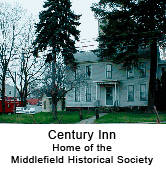 In 1958, local businesspeople were looking for ways to promote the village and decided to feature its newest industry. The Middlefleld Swiss Cheese Festival was born of the combined efforts of the Chamber of Commerce and the Middlefield Volunteer Fire Department. Held every Father’s Day weekend, the Festival grew yearly, with one of the best parades around. The last Swiss Cheese Festival was held from June 14th through 16th, 1991.
In 1958, local businesspeople were looking for ways to promote the village and decided to feature its newest industry. The Middlefleld Swiss Cheese Festival was born of the combined efforts of the Chamber of Commerce and the Middlefield Volunteer Fire Department. Held every Father’s Day weekend, the Festival grew yearly, with one of the best parades around. The last Swiss Cheese Festival was held from June 14th through 16th, 1991.
The aim of the first Mayor and Council has been realized. Middlefield Village is now one of the most prosperous villages of its size in Northeast Ohio. Thanks to the many industries located here, the residents enjoy a high tax base, low unemployment, low utility rates and real estate taxes, and many services. According to the NOACA traffic count, 44,600 vehicles per day pass through the downtown intersection.
Local businesses are thriving and more are locating here all the time, giving residents more and more conveniences.
Yesterdays
Yesterdays originated as a series of articles written for the Middlefield News by former Council member Rick Seyer in anticipation of the Middlefield Village Centennial, to be celebrated in 2001. In his preface to the series, Seyer wrote: This year the Village of Middlefield will celebrate its centennial. I will try to provide articles for the newsletter that will follow the history and progress of our village during its first year. Every attempt will be made to be historically accurate. Information that you may have to share relating to the first year of the village would be much appreciated.
It was on Saturday, December 1, 1900, that the Middlefield Township trustees met in special session at the town hall to accept a petition signed by 45 electors, a majority of whom were landowners, to request the right to vote on the formation of a new village to be called Middlefield.
The size of the proposed new village was a perfect square with the boundaries being as follows; to the East near what is today Lenny Dr., to the North where the present day boundary is near Mary Yoder’s Restaurant, to the West near Russell Funeral Home, and South just past Sajar Plastics. In each direction, there are still some of the original boundary lines used today. There were approximately 600 people living in the proposed village then.
The township trustees set an election for Saturday, December 15,1900 on the question of incorporation. Notice was published in the local newspaper, the “Middlefield Messenger”. Henry Thompson, a descendant of Isaac Thompson, the first settler, was named as agent for the petitioners.
On the appointed day, 142 voters turned out to vote on the question of incorporation. The results showed 80 votes for incorporation and 62 against. Since there was a majority for incorporation, the township trustees then made an order declaring the above described territory to be a village and to be known by the name Middlefield. This was the beginning of the 100 years of history we will be celebrating this year.
In December 1900 the electors in Middlefield voted to form a new political subdivision to be known as the Village of Middiefield. The election for the first Mayor and Council was held on April 1,1901- J0E E. J0HNSON, who at that time was President of the Ohio Pail Company, forerunner to the present day Johnson Rubber Company, was elected the first mayor. Johnson lived on Lake Avenue in the century home on the only farm now left in the village, currently owned by Jonathan J. Miller, located south of Grove Street on the opposite side of the road. This home was also the first home in Middlefield to receive electricity; wired during the time Johnson lived there.
Council members elected were C.E. LAMPSON, HENRY THOMPSON, H.L. WRIGHT. C.L SMITH, J.J. ROSE and C.P. PATCHIN. These elected officials provided the foundation for the 100 years of progress we enjoy today. The first council meetings were held at the town hall, in the building now located east of Western Reserve Farm Co-op on Rt. 87.
The following is a transcript of the first “State of the Village” message, given at the first meeting of the newly elected council.
“Gentlemen of the Council: It has long been the custom, and is considered by some to be an absolute necessity, for the mayor at the first meeting in April of each year to make an address or present an annual message to the council. As this is the first regular meeting of the newly incorporated Village of Middlefield, I take great pleasure in congratulating the members of this honored body on their election to the first council of the Village of Middlefield. And well should it be considered an honor, and at the same time you should not forget its responsibilities, as in your first year deliberations you surely plant the embryo, which in future times may mature and cause disaster or success. In other words you make the foundation. You form the precedents for your successors for years to come.
In taking up this movement, the incorporators had but one aim in view. That was to improve and make Middlefield Village one of the pretty and prosperous suburbs of the magnificent city of Cleveland. But now, while our purposes and aims are certainly superb, we should not be led astray and be led to believe that because we are incorporated, we may have all the blessings and comforts of larger and more populous cities and villages. You, as councilmen, should guard well our village treasury and try to keep within a moderate rate of taxation. Incorporation does not necessarily mean extravagant expenditure. We should all work together for the most good to the greatest number. You are faced at the present time with an empty treasury and you will receive but little, if any, money from taxation before next year; but fortunately the law provides for cases of this nature and I hope that you will take the benefit of this law to provide for the necessary funds to carry on the business of the incorporation until that time.
It is my opinion that the best course to pursue would be to curtail expenses in every department and make such improvements for 1901 as necessity demands. My advice would be go slow but go sure. What we want you to build is a foundation for the nicest and most prosperous village in northeast Ohio.
Among your first duties you will have to pass ordinances, provide bonds for municipal officers and also prescribing rules for the transaction of business.
I trust that, as your presiding officer, you may at all times bear with me in my mistakes as my only aim shall be to rule wisely and impartially.”
J.E. Johnson
Mayor
These words spoken 100 years ago provided the foundation that Village Council today still strives to build on.
In 1901, Council Deals With Mud, Stagnant Water and No Money
In the previous two segments of this history, we learned about the formation of the Village of Middlefield and the election of its’ first mayor and council. The village that formed over 100 years ago bears little resemblance to the village we live in today. The residents of 1901 traveled the village on dirt streets. East Elm, West High, North State and South Main, as they were known then, were nothing but muddy quagmires every time it rained. In 1901, everyone traveled about in a horse and buggy or wagon. The first automobile did not appear in town until somewhat later and I believe it was owned by someone in the Johnson family. Yankee and Amish alike all used the same mode of transportation. The buggy styles may have been different but everyone used a horse.
The early months of the first council were concerned with surveying for sidewalks so residents would not have to walk in the mud streets. Since there were no storm sewers to drain away rainwater, the first council sent many letters to residents urging them to drain stagnant water from the road right-of-way. There were also many letters sent to residents warning them that the draining of their septic systems into the ditches and creeks in the village would not be allowed to continue. There was no village water or sewer system like today. These would not come for another 50 years.
| The first council had to find a meeting place to hold council meetings. Early records show that two rooms on the second floor in the rear of the Lampson and Usinger building were rented for council chambers. This building is believed to have been the former K of P building located where the Middlefield Banking parking lot is now. | A bill was presented for the cost of furnishings for the new council chambers for the following items: | ||
| 1 Gasoline lamp 1 Hand lamp 9 Chairs 6 Chairs 2 Window screens 1 Large table |
5.75 0.35 18.75 5.00 0.60 10.00 |
||
| Total | $40.45 | ||
| The records also show that for the first year the village did not receive any tax money to operate on. Even then taxes were collected one year behind. It wasn’t until 1902 that taxes could be collected for 1901. Since there were no banks in town, (Middlefield Banking did not begin operations until September 1901) village council on May 20,1901 borrowed the sum of $300 from resident Frank P. Work to be repaid by March 1, 1902 at the rate of 6% interest. This money was placed into the village treasury to be used for its day-to-day operations.These were just a few of the issues and problems faced by Middlefield’s first village officials. In the next issue, we will learn about some of the first ordinances that were passed and about the development of the telephone and electric systems.In a personal note, it was with a sincere twinge of sadness that I recently witnessed the last member of the Johnson family moving from Middlefield. Joe and Kay Johnson moved to their new condominium In Aurora. The Johnson family had resided in Middlefield for over 200 years, and were undoubtedly the single most influential family responsible for the growth and progress of our community during the past 100 years. We wish them well- R.S. | |||
Historical Mural Completed

Much interest has been shown in the recently completed mural on the northeast corner of the intersection of state routes 87 and 608. This project was a final piece in the downtown intersection beautification program begun during my previous administration as mayor in 1983. The mural was designed and painted by the graduated Cardinal Middle School 8th grade Art Class under the direction of Art teacher Christie King. Three middle school students, Brandon Templeton and Jeremy Bratnick, along with Rachael DeMay, were instrumental in organizing and designing the mural project. The mural is actually a composite of 5 photos taken between 1900-1915. These photos were used to create the mural of what downtown Middlefield looked like during these years. This is a composite drawing of the mural as put together by Brandon Templeton. It was copied to a transparency and then projected onto the wall. The middle school art students traced the outlines on the wall and then painted it in.
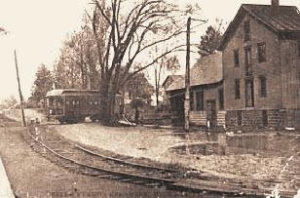
| This photo shows an interurban car from the Cleveland and Eastern Electric Railway that ran between Middlefield and Cleveland, a trip that 2 hours 25 minutes. Middlefield was actually the end of the line and the car in the picture is turning around the creamery, site of the present American Cancer Societys’ Good Buys, Too Shop. The line ran From Middlefield to Burton and Newbury and on to Cleveland and back and was a major transportation method during the time when most people still drove a horse and buggy. The tracks in the picture ran along the front of the present CVS building into the car barn in the next picture.
|

This picture shows an extended view of the same area. The creamery is the building on the far left along the street. The next building coming up the street is a tavern and is the same building that today houses the Town Tavern. The building with the big opening in front is the car barn for the interurban car in the previous picture. The Baltimore & Ohio railroad tracks are next and the building on the corner is the H. B. Castow Drug and Stationary store. Note the mud streets.
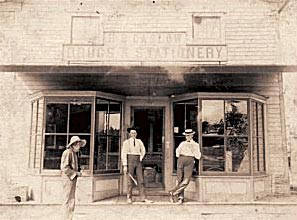
| This picture shows a close up of the Caslow drug store with owner Harry B. Caslow on the right, Robb Rose in the center and local hermit and eccentric Myra Raymond on the left. Robb Rose was one of the early officials of the Middlefield Banking Company and was the father of current resident Jim Rose. Myra Raymond lived on Budysburg Rd, north of Rt. 87, and many years later was found murdered in his home. |
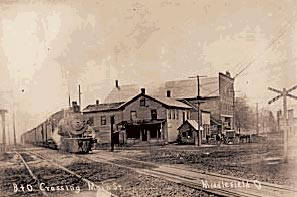
| This picture, beginning on the left, shows just a small corner of the porch of the Hotel that sat directly on the corner where the green space and parking area of the present day CVS store Is located. The B&O railroad crossing is next. The train ran between Painesville and Warren for nearly 100 years, stopping in the late 1970’s. Early on it carried passengers and then freight and then coal. Next you see the “Drug and Stationery” store owned by Harry Caslow, grandfather of present day residents Jane Eaton and her sister Ann Reed. Next in the background is a building that housed a harness shop. The next building, the tall one, is the Doerfer building. This building housed a general store and many years later was known as the Eppley Building. It was also known for many years as the “garter factory” where garters were manufactured by Eppley products. Across the street. Just past the railroad crossing sign. Is the present day Geauga Vision building that housed a back then. This building and the Town Tavern building are the only buildings still standing that are depicted In the mural. | |
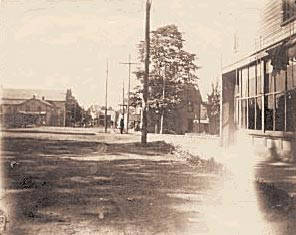 |
This picture shows the gazebo bandstand located just south of the intersection. The building on the right of the bandstand Is the “Post Office”.The building in the foreground on the right is a dry goods store and the building on the far left in the background is the Caslow Drug store. |
Centennial Year Comes to a Close
| Pictured are Claire Lampson and his son Lynn Lampson, owners of C E Lampson and Son Hardware. In 1910 C E Lampson built the Lampson building where the former Roose Drug was located. The hardware store occupied the west end of the building, in one half the area now occupied by Specter’s. C E Lampson was also one of the early directors of Middlefield Banking Company. | 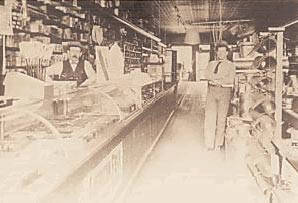 |
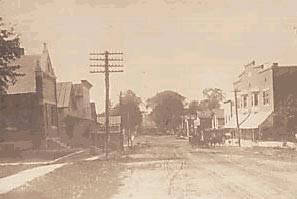 |
This view is looking west on East High Street toward the downtown intersection. It was taken within the vicinity of the current Post Office. The original Middlefield Banking Company building is on the left and the Lampson Building on the right. Note the dirt street. Sometime around 1915, the street was concreted. |
| This view looks east on East High Street, in an even earlier time than the previous picture, probably 8-10 years earlier. Note the Henry Thompson store, behind the wagon. Thompson was a direct descendant of Isaac Thompson, the first settler in Middlefield. The next building is the first location of the C E Lampson and Son Hardware. Next is a private residence and then the Middlefield Banking Company. | 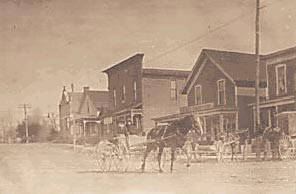 |
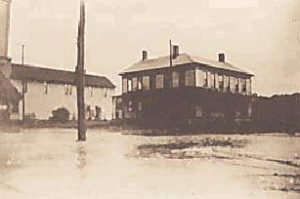 |
The old hotel sat on the comer where CVS is now located. The passenger trains and the streetcars that came through Middlefield all stopped near the hotel. All the towns’ people knew the train schedule. It was an exciting time when the trains arrived, and everyone turned out to greet them and see who was getting off. Middlefield at one time had three train lines all coming in to town in the same years. This picture was taken after one of Middlefield’s earlier floods. |
A Look Back In Time …
| This basket factory was located on the place presently occupied by the big blue building on South Thompson Ave. where Johnsonite is now located. It is believed that a family known as the Steele brothers owned this factory. Not much is known about the factory so if any reader has any information, please contact the village hall. | 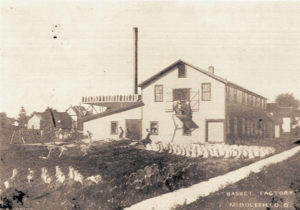 |
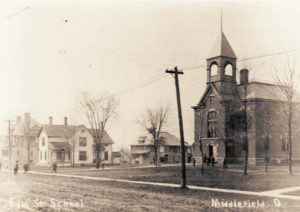 |
Here is a picture of the school building that was on the site before the present day middle school was built. This building housed all 12 grades and was built in 1892. Next to the building is a home where the library is currently and next to that is the Gooding home that was moved up on North Thompson. The Evans Medical Center now occupies this site with their present rear attached building in the center. |
| The Ohio Pail Company, today known as Duramax/Johnson Rubber Company, was located at the same site it occupies today. They first produced various types of wooden pails and then later got into the steel pail business. This picture was taken looking south on South Thompson Ave. Note the handrails on the sidewalk bridge where the creek still runs today and the curve in the street where today it becomes Johnson Street. | 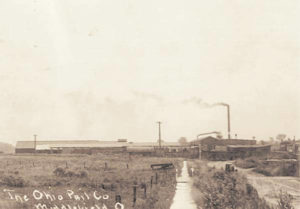 |
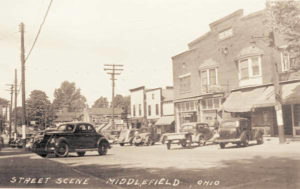 |
Back before traffic was a problem, both sides of East Elm Street where used for angle-in parking. This picture was taken around 1940 and shows the same building that is there today but with many different businesses. The first tenant on the far right end was the Post Office, next was William Duchac Drug Store, then Dean’s Department Store and last was Lampson Hardware. Karl’s Jewelry was Patchin’s Meat Market, and next to that was Gates 5 & 10. Then cam Pete’s Popovic’s Tavern, the Open Kitchen Restaurant and on the corner, Canfield’s Filling Station. |
| This is Mineral Lake taken in 1944. Note the diving board platform and the guardrail to prevent swimmers from “going off the deep end”. It was quite a popular place back then. There were even small amusement-type rides located in Mineral Lake Park, although at a much earlier time than this photo. Gene Esenwine took this picture at the end of Sperry Lane. | 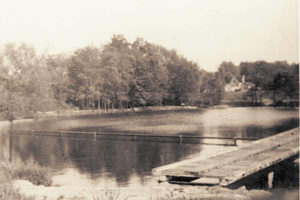 |
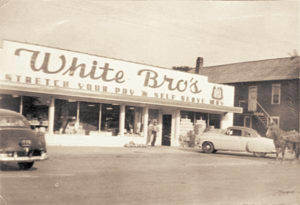 |
The original White Bros. Grocery store in the early 1950’s. At the time this was the most modern grocery store in Geauga County because of the new “self serve” concept. Sign says “Stretch Your Pay The Self Serve Way”. This building currently houses H&R Block and El Hombre Barber Shop. The building next door is the Geauga Vision Building. |
| A picture of “Dicker Days” celebrated in Middlefield during the summer months just after the turn of the century. It was like a community sale day when farmers brought their animals to town to sell and pens were built right on East High Street, This picture shows the pens constructed on the south side of East High Street. Buildings shown are where the Middlefield Bank building and parking lot are located. | 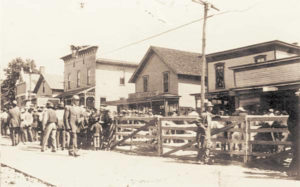 |
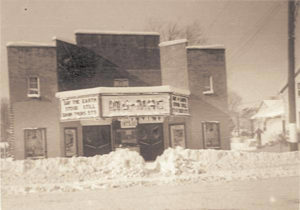 |
Middlefield’s own movie theater, the “MuMac”, was named for it’s original owners, Ken Mumaw and Dr. George McLlroy, a dentist and former mayor. The theater lasted only about 10 years. It opened just about the time television became popular and by the time it closed, most people stayed at home and watched movies on TV. This building currently houses the “Petal Pusher” and “Linda’s Restaurant”. Note the three-foot pile of snow in front. |
| This is an early picture of the Municipal Parking Lot taken from the rear of the Fig Tree/Spector’s building. The parking lot was not yet a reality. First there was the job of enclosing the creek that ran through it. Basically a box culvert was constructed that allowed the construction of the parking lot. The culvert is still there today but the creek was rerouted in 1995 right through the center of the intersection of Rt. 608 and Rt. 87. The building visible at the edge of the parking lot with the creek running under it at one time was the Bowling Alley. The building at the top right side is the Geauga Vision building. | 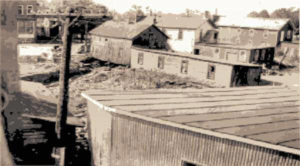 |
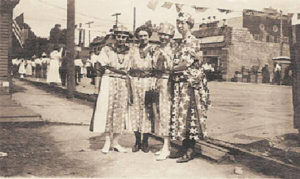 |
This is a quartet of local ladies dressed in their 4th of July finest at one of Middlefield’s community celebrations taken sometime in the 1910’s. From left to right are Ethel Ritchie, Olive Rhodes, Edith Ritchie and Louise Bundy. Middlefield really did the 4th of July up big with a parade, fireworks and food. Note how dressed up everyone in the background is. Both men and women put on their finest to come to town to the celebration. The building immediately behind the ladies is on the corner where Mural Park is now located. This building was removed to construct the turn lane. |
| This depicts how life in Middlefield was in the late 30’s, early 40’s on a summer day. No real hustle and bustle, time went by a lot slower, and no one was in a hurry. Orville Burnett is playing catch in front of what was then Patchin’s Store and Pete’s Tavern. The gentleman sitting on the benches don’t seem to have a care in the world. Note the prices on brooms back then, only 39 cents. Patchin’s Store was located where Smoker Friendly is and Pete’s Tavern is now Middlefield Tavern. Note the canopy roof over the sidewalk at Pete’s Tavern. | 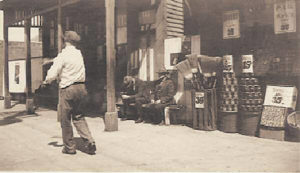 |
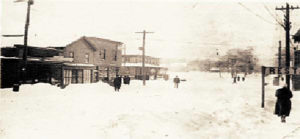 |
Just so we all don’t forget what a typical Geauga County winter we just had, here is a picture of the winter 0f 1919. This view is looking southwest, taken from about the spot in front of Karl’s Jewelry. The first three buildings from left to right are where Middlefield Bank’s parking lot is now. The last building near the center of the picture is the old hotel, located where CVS is now. The hotel served as a center of community social life. The train stopped near the hotel and a great interest at the time was trying to guess what business the strangers who got off the train and went to the hotel had in the community. |
| East High Street in the early 1950’s. The buildings were all located on the south side of the street where Middlefield Banking’s parking lot is now. Middlefield 5 to $1.00 was owned by Maude Lorson, mother of former Fire Chief Earl Warne. Next door was Edith Ritchie’s Dry Goods. Downstairs below Lorson’s Golden Dawn Supermarket was the Nibble Nook, A restaurant and upstairs was the local K of P Lodge. Next was Middlefield Hardware owned by Charlie Harrington. The last commercial building was the Middlefield Banking Company. | 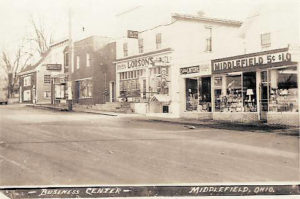 |
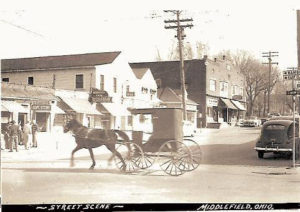 |
This is the other side of East High Street at about the same time. The license plate on the parked car says 1951. The first store was Schneider’s Department Store. Next door was the Middlefield Inn Restaurant. Then came Middlefield Tavern and The Dress Shoppe. Next was Karl’s Jewelry. In the Lampson Block, there was the Village Hardware, Kleinfield and Bostwick’s Department Store, Bill Barnes Drug Store and the Middlefield Post Office. All of these buildings except the first two are still there and two of the same businesses still occupy their locations. |
| White Brother’s Food Store was located on North State Avenue where H&R Block is now located. Originally it started out as a produce market, operated by 5 of the White brothers and was located on East High Street in the location previous noted as the Nibble Nook. Basil and Junior White decided to expand the business to include groceries and opened their own store in the late 1940’s. As the business grew, it was expanded and the building was enlarged many times. In 1966, they built the building now occupied by Sparkle Super Market, advertised at the time as “Geauga’s Most Modern Supermarket”. | 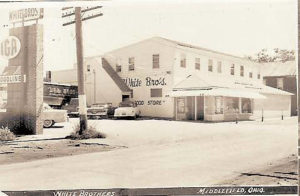 |
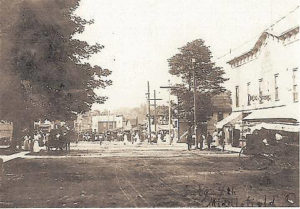 |
The 4th of July celebration in Middlefield 1908. The location is South State Avenue looking north toward the intersection. Woodside Drug Store is the first building and the Middlefield Post Office is the next building. This building was moved and attached to another as part of the buildings behind the Geauga Cleaners building on West High Street. Note the dirt street and how dressed up everyone was. The ladies in their long dresses and the gentleman in their suits and hats. The bandstand is decorated with banners and flags for this most festive celebration. |
A note from the Author:
IF you have any photos to share, please contact the village at 440.632.5248 and leave a message and I will get back to you. Any photos showing identifiable people, places, businesses, industries, etc. would be very much appreciated and all photos will be returned.Rick Seyer